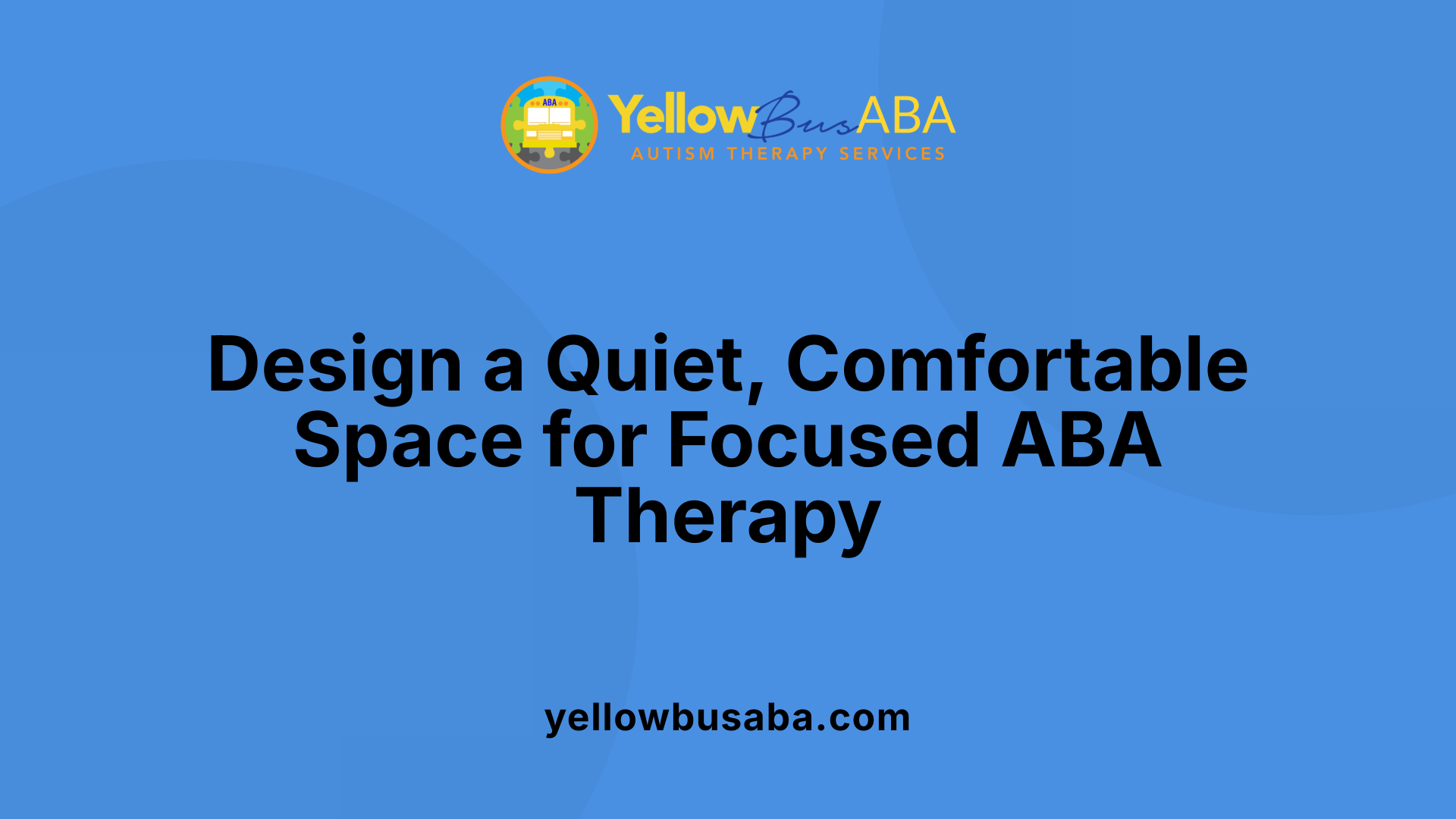Understanding the Foundations of a Supportive Home for ABA
Creating a home environment conducive to Applied Behavior Analysis (ABA) therapy is crucial for maximizing a child's developmental progress. This comprehensive guide explores practical strategies, collaboration tips, and environmental modifications to support effective ABA interventions at home.
Establishing a Dedicated, Organized Space for ABA Activities

How can I set up an environment at home that is conducive to ABA therapy?
Creating the right home environment is essential for effective ABA therapy. The goal is to establish a space that promotes focus, safety, and comfort, making therapy engaging and productive.
Begin by designating a specific area that is quiet and free from high traffic. This helps reduce distractions and allows the child to concentrate fully on therapy activities. Soft lighting and calming colors—such as pastel shades—can create a relaxing atmosphere that supports sensory regulation and minimizes overstimulation.
Organization is also crucial. Use labeled bins or shelves to store therapy materials, reinforcement tools like stickers or toys, and visual supports such as schedules or picture cards. Easy access to these items ensures that sessions run smoothly and efficiently, encouraging independence and routine.
Reducing sensory distractions involves managing noise levels with sound-absorbing materials like rugs or curtains. Consider using noise-canceling headphones if needed. Keeping visual clutter to a minimum helps the child focus on what’s important during therapy.
Incorporating visual supports, such as visual schedules and picture-based instructions, makes routines predictable. These tools help children understand what to expect, reducing anxiety and promoting engagement.
Finally, establishing clear routines within this space and reinforcing positive behaviors with praise or rewards can boost motivation. Creating a safe, sensory-friendly environment tailored to the child's needs helps foster consistency, minimizes stress, and supports ongoing skill acquisition.
Collectively, these steps establish a dedicated, organized setting that lays the foundation for successful ABA therapy at home, enabling children to learn and grow in a supportive, structured environment.
Implementing Visual Supports and Routines
What are effective strategies for creating a supportive environment for at-home ABA therapy?
Creating a positive and consistent environment at home is essential for successful ABA therapy. One of the most effective strategies is establishing clear, structured routines that provide predictability and reduce anxiety for the child. Visual supports such as schedules, picture cards, and charts help children understand daily activities and transitions, making routines more concrete and manageable.
Use visual schedules, picture cards, and charts to create predictable routines.
Visual tools serve as visual cues that guide the child through their day. For example, a visual schedule with pictures representing activities like brushing teeth, playtime, and mealtime helps children anticipate what comes next, reducing resistance and promoting independence. Charting progress with visual reinforcements also keeps the child motivated and engaged.
Establish consistent daily schedules for activities, mealtimes, and transitions.
A set schedule, reinforced by visual supports, helps children develop a sense of security. Consistency in mealtimes, bedtime, and activity transitions creates stability. Using visual timers or countdown charts signals upcoming changes, helping children adjust smoothly and minimizing behavioral issues while promoting a sense of ownership over their routine.
Incorporate visual supports into daily activities to reinforce understanding and reduce anxiety.
Embedding visual aids during daily routines enhances comprehension and comfort. For example, using picture prompts for self-care tasks, like handwashing or dressing, can promote independence. Consistent use of visual supports across settings enables the child to generalize skills, and incorporating them into fun, everyday activities makes learning engaging.
Practical Tips for Implementation
- Create a dedicated space for visual supports that is easily accessible.
- Involve family members in creating and maintaining visual tools.
- Regularly update and modify visual supports based on progress and evolving needs.
- Celebrate milestones and progress to boost motivation.
Collaborating with professionals, such as certified behavior analysts (CBAs), can assist in designing effective visual supports tailored to your child's unique needs. Training family members to use these tools consistently ensures that routines are reinforced and behaviors are generalized across different settings, leading to a more effective and comforting home environment for ABA therapy.
Creating a Calm, Sensory-Friendly Environment

How can I set up an environment at home that is conducive to ABA therapy?
Creating an environment that supports ABA therapy involves thoughtful planning and arrangement of your home to foster focus, relaxation, and learning. The first step is to designate a specific space that remains consistent for therapy activities. This area should be quiet, low in traffic, and free from distractions, helping the child concentrate on tasks without feeling overwhelmed.
Incorporate sensory-friendly furnishings like soft lighting, calming colors, and comfortable seating to create a soothing atmosphere. Using sound-absorbing materials such as rugs, curtains, or wall hangings can help manage noise levels, which is particularly important for children sensitive to auditory stimuli. Noise-canceling headphones are also an option to reduce auditory distractions during activities.
To facilitate smooth therapy sessions, organize materials—like visual supports, reinforcement tools, and daily routines—in labeled, easily accessible spots. Visual aids such as schedules, picture cards, and visual instructions help make routines predictable, reducing anxiety and encouraging independence.
Reducing visual clutter and managing sensory input is essential. You can achieve this by maintaining a clean, organized space with clutter-free surfaces and using calming visuals. Establishing consistent routines and using positive reinforcement techniques within this environment further supports ongoing development.
For example, setting up a dedicated 'learning corner' with minimal noise and clutter enables children to focus better and feel secure. Incorporating sensory-friendly furnishings and reducing overstimulating stimuli creates a safe space where children can engage meaningfully in therapy activities, ultimately promoting growth and positive behaviors.
Collaboration with Professionals and Parent Training
How can collaboration with ABA providers enhance home support?
Working closely with ABA providers significantly boosts the effectiveness of home-based therapy for children with autism. When parents and caregivers collaborate with professionals, they ensure therapy strategies are consistently applied, which is crucial for reinforcing skills learned during formal sessions.
A strong partnership allows for tailored interventions that align with the child's unique needs and family routines. Regular communication with ABA providers offers opportunities for parents to receive personalized advice, coaching, and feedback. This ongoing dialogue helps caregivers understand how to adapt techniques successfully in everyday settings.
Parents can participate in training sessions provided by ABA professionals, gaining essential skills for implementing behavior modification strategies at home. These sessions include demonstrations on using visual supports, applying positive reinforcement, and managing challenging behaviors. As parents become more confident in these methods, they are better equipped to support their child's development.
Maintaining frequent updates and check-ins allows providers to monitor progress, make necessary adjustments, and ensure consistency. This collaborative approach fosters a sense of teamwork, builds parental confidence, and leads to improved behavioral and developmental outcomes for the child.
In summary, partnering with ABA specialists transforms home environments into supportive, structured spaces where children can thrive. Such cooperation not only enhances the application of therapy but also empowers families to play an active role in their child's growth and success.
Supporting Communication Development and Reinforcement
How can visual supports be used to enhance communication skills in children undergoing ABA therapy?
Visual supports are a fundamental tool in supporting communication development at home. Picture exchange systems, visual schedules, and communication charts help children understand routines and express their needs effectively. These tools make abstract concepts more concrete, allowing children to anticipate what will happen next and reduce anxiety. Visual schedules, for example, outline daily activities with pictures, providing clarity and structure.
Creating a communication-friendly environment involves placing visual supports at accessible locations and integrating them into everyday routines. By consistently using images to prompt and reinforce communication, children learn to make choices and communicate their preferences more independently.
How can parents encourage communication through everyday interactions and social routines?
Daily interactions with your child are a prime opportunity to foster communication skills. Engaging in activities like play, mealtime, and routine transitions encourages children to use language or communication gestures. Using visual supports during these routines helps children practice expressive language and understand social cues.
Reinforcing attempts to communicate, even if nonverbal, boosts confidence. For example, acknowledging a child's gesture or sound with praise encourages further communication efforts. Incorporating turn-taking games and social routines, such as greeting family members or sharing toys, further develops social language skills.
What strategies best reinforce positive behaviors with praise, rewards, and other motivators?
Reinforcement is central to ABA therapy, and using praise, tangible rewards, or preferred activities can effectively motivate desired behaviors. Immediate positive feedback, such as verbal praise (
Reinforcing Skills and Monitoring Progress
What are best practices for supporting a child's development through at-home ABA therapy?
Supporting a child's growth with ABA therapy at home involves multiple strategies. Collaborating closely with qualified professionals helps tailor interventions suited to the child’s unique needs.
Creating a consistent daily routine is fundamental. Using visual schedules and clear expectations makes daily activities predictable, reducing anxiety and promoting engagement. Setting up a quiet, organized environment with minimal distractions allows children to focus better during therapy sessions or play-based learning.
Positive reinforcement is central to encouraging desired behaviors. Using immediate praise, stickers, or small rewards reinforces learning and motivates children to practice new skills. Celebrating milestones, such as mastering a new communication skill or social behavior, boosts confidence and morale.
Tracking progress regularly helps parents and therapists understand what strategies are effective and where adjustments are needed. Journals, data sheets, or digital logs enable precise monitoring of behavior changes and skill acquisition over time.
Consistent application of techniques, ongoing parent training, and open communication with therapists ensure that the child's therapeutic needs are being met across different environments. This collaborative, structured approach maximizes developmental gains.
How can parents implement these ABA strategies at home?
Parents can start by establishing routines that include visual supports and designated spaces for learning. Reinforcing positive behaviors immediately and consistently makes children more likely to repeat desirable actions.
Monitoring progress through simple charts or journals can provide valuable insights for adjusting strategies. Celebrating small wins keeps motivation high and nurtures a child's self-esteem.
Engaging in regular training sessions offered by ABA providers equips parents with the necessary skills to implement techniques correctly and confidently.
Building a support network with other parents and professionals offers further encouragement and practical advice. This community support helps maintain motivation and ensures that therapy remains consistent and effective.
What are best practices for supporting a child's development through at-home ABA therapy?
| Practice | Description | Benefit |
|---|---|---|
| Collaborate with professionals | Work closely with behavior analysts and therapists for tailored strategies | Ensures individualized, effective intervention |
| Establish routines | Use visual schedules, consistent mealtimes, and clear transition signals | Builds security and reduces anxiety |
| Use positive reinforcement | Praise, rewards, and tangible reinforcements after desired behaviors | Motivates ongoing progress, builds confidence |
| Track progress regularly | Maintain journals or data sheets to monitor behavioral changes and skills | Guides adjustments and celebrates progress |
| Create a conducive environment | Organize a quiet, distraction-free space for therapy and learning | Enhances focus and reduces overstimulation |
| Involve parents continuously | Use parent training and consistent reinforcement techniques | Promotes generalization of skills across settings |
More information
Tracking progress in ABA at home is an essential aspect of effective therapy. It provides concrete data that helps parents work with professionals to refine interventions, making updates based on actual progress. Regular monitoring enables the recognition of patterns, skill acquisitions, and behavioral improvements, facilitating an adaptive approach that keeps the child's development on track.
Building a Support Network and Continuing Education

How does collaboration with ABA providers enhance home support?
Working closely with ABA professionals, such as certified behavior analysts (CBAs), significantly strengthens the support system at home. These professionals help parents understand their child's unique needs and provide tailored strategies to incorporate ABA techniques effectively into daily routines.
Building a partnership with ABA providers involves regular communication, joint planning, and feedback. This collaboration ensures consistency in how behaviors are reinforced and new skills are taught, which is vital for successful outcomes.
Through ongoing training sessions, parents learn practical methods for applying behavioral strategies, managing challenges, and tracking progress. Coaches and consultants also offer support, helping families adapt techniques to fit their routines and environment.
By fostering this cooperation, families gain confidence and clarity, making therapy more effective and sustainable. It also creates a cohesive approach where therapy extends seamlessly from professional sessions into everyday life, maximizing developmental gains.
Connect with other parents and professionals for insights and encouragement
Joining support groups for parents of children with autism offers emotional encouragement, practical advice, and shared experiences. Peer support networks can be found locally or through online forums, providing access to a community that understands specific challenges.
Engaging with other parents helps in exchanging successful strategies, navigating setbacks, and celebrating milestones. Connecting with professionals such as speech therapists, occupational therapists, and behavior analysts further enriches the support system, granting access to expert guidance.
Attend training sessions and workshops related to ABA
Many ABA providers offer training programs, workshops, and seminars designed to teach parents effective techniques. These educational opportunities cover topics like creating visual schedules, implementing reinforcement strategies, and managing common behavioral issues.
Attending these sessions enhances parents' skills and confidence, fostering consistency in applying therapy methods at home. Workshops also provide opportunities to ask questions, receive personalized feedback, and stay updated on best practices.
Stay informed about new strategies, resources, and research developments
The field of autism intervention continually evolves with new research and innovative approaches. Parents should stay informed through reputable sources, professional organizations, and ongoing education.
Reading current literature, joining webinars, and participating in conferences can introduce fresh ideas and validated methods that may benefit their child.
Summary of Strategies for Building Support and Continuing Education
| Strategy | Description | Benefits |
|---|---|---|
| Partner with ABA professionals | Collaborate with certified analysts for tailored support | Improved consistency and tailored interventions |
| Join parent networks | Connect with other parents for support and tips | Emotional support and practical advice |
| Attend training/workshops | Participate in educational sessions on ABA techniques | Increased skills and confidence in applying ABA |
| Stay updated on research | Follow new developments and resources in autism care | Access to latest effective strategies |
Building a support system through collaboration, education, and community involvement empowers families to implement effective ABA strategies, fostering lasting progress and improved well-being for children with autism.
Monitoring and Adjusting Strategies for Success

How should progress be reviewed and strategies adjusted?
Regularly assessing a child's development is vital when implementing ABA therapy at home. Parents and caregivers are encouraged to track behaviors, skill acquisition, and response to interventions through consistent note-taking or journaling. This data helps identify what strategies are working well and what areas need more attention. Based on these insights, adjustments to the intervention plan can be made to better suit the child's evolving needs.
Therapists and behavior analysts often recommend scheduled reviews to evaluate progress and recalibrate goals. These reviews ensure that interventions stay aligned with the child's developmental trajectory, allowing for the modification of techniques or reinforcement strategies to enhance effectiveness.
How can data be used to inform decisions and set new goals?
Using data-driven approaches helps to make objective decisions about a child's progress. Quantitative data such as frequency counts, duration of specific behaviors, or success rates on tasks can reveal patterns that guide therapy adjustments. For instance, if a child's communication skills improve with certain prompts, those prompts can be reinforced or expanded.
Additionally, setting new, achievable goals based on current progress keeps the therapy meaningful and motivating for both children and parents. Goal-setting should be collaborative, involving input from professionals and family members, to reflect the child's changing abilities and interests.
Why is flexibility important when adjusting ABA strategies?
Children with autism are unique, and their needs can change rapidly. Flexibility allows parents to adapt strategies to suit current circumstances, such as changes in daily routines, environment, or behavioral responses. Being open to trying new reinforcement methods or modifying the learning environment can improve engagement and reduce frustration.
Support from professionals is crucial during these adjustments. ABA providers can help interpret data, suggest modifications, and introduce new techniques. This collaborative approach ensures that interventions remain relevant, effective, and child-centered.
Practices for supporting development through at-home ABA therapy
Supporting a child's growth with ABA at home involves establishing a structured environment that fosters learning. This includes creating visual schedules, routines, and designated spaces for therapy activities to promote consistency.
Parents should incorporate positive reinforcement, such as praise, stickers, or small rewards, to motivate behaviors and celebrate milestones. Routine tracking helps monitor progress and inform necessary adjustments.
Collaboration and ongoing education are essential. Parents should engage with certified professionals for guidance, participate in training sessions, and maintain open lines of communication.
Building a support network with other parents and community resources can provide ongoing encouragement and practical insights. Ultimately, flexible and data-informed strategies tailored to the child's needs pave the way for meaningful developmental gains.
| Practice Area | Description | Helpful Tools |
|---|---|---|
| Regular Review | Weekly or bi-weekly assessment of progress | Observation notes, journals |
| Data Collection | Tracking behaviors and responses | Charts, apps |
| Goal Adjustment | Modifying goals based on progress | Collaborative plan updates |
| Environment Setup | Structured routines and spaces | Visual schedules, quiet zones |
| Positive Reinforcement | Rewards for desired behaviors | Stickers, praise, toys |
Achieving developmental progress through at-home ABA therapy is an ongoing process that benefits from attentive monitoring, flexible strategies, and active collaboration with professionals. When parents incorporate these practices, they can create a supportive environment that fosters growth and learning in children with autism.
Empowering Families and Children for Long-Term Success
Creating an optimal environment for at-home ABA therapy is vital for achieving meaningful progress and supporting the child's overall development. By establishing a dedicated, sensory-friendly space, utilizing visual supports, collaborating with professionals, and reinforcing skills through daily routines, families can significantly enhance therapy effectiveness. Ongoing education, community support, and flexible, data-driven adjustments ensure that strategies remain aligned with the child's evolving needs. Ultimately, a supportive, well-structured home environment empowers families to foster independence, resilience, and sustained growth for children with autism.
References
- Implementing In-Home ABA Therapy
- Supporting Your Child's ABA Therapy at Home: A Parent's Guide
- How to Create an ABA-Friendly Home Environment
- How Parents Can Use ABA Techniques at Home
- Creating an Autism-Friendly Home Environment
- How to Prepare Home for In-Home ABA Therapy | Inclusive ABA
- Creating a Sensory-Friendly Home Environment for Children with ...
- How to Create an ABA-Friendly Home Environment
- Setting the Stage: Optimal ABA Therapy Home Setup Strategies
- Supporting Your Child's ABA Therapy at Home: A Parent's Guide



.jpg)

.avif)
